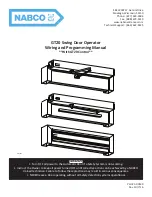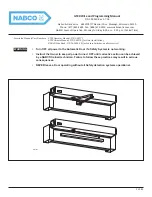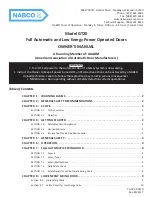
WHITEHALL MANUFACTURING
• P.O. BOX 3527 • City of Industry, CA 91744-0527 U.S.A
Phone (800) 782-7706 • (626) 968-6681 • Fax (626) 855-4862 • Web: www.whitehallmfg.com
Instructions for Operation and Care of Little Therm Compact Thermalator
•
•
•
•
•
•
•
•
•
CLEANING AND STERILIZING
very mild, non-scratching household cleaner and a very
low abrasion plastic scouring pad lightly applied. On a
stainless steel tank, never use a metal scouring pad as it is
too abrasive and may leave carbon metal deposits on the
stainless which will rust.
Again, disinfection and sterilizing is different from facility to
facility, and we have found that alcohol is still the best (but
expensive) cleaning and sterilizing solution. Bleaches and/
or iodine should not be used, but if they are – if they must be
– that thorough rinsing of all metal parts be accomplished.
Never should bleach or iodine be allowed to “soak” on
the surface of stainless steel without the solution being
immediately washed completely off.
Initial evidence of excessive bleach and/or iodine use or lack
of thorough rinsing will be a dulling appearance.
Continued use of such practices will result in pin holes in
the stainless steel tank and leaking.
MAINTENANCE
Cleaning of the tanks can best be accomplished with a
11
The Little Therm design is nearly maintenance-free. It
should, under most conditions, give many years of reliable
service. Clean and replace the Thermal Packs as described
below.
1. Routine Maintenance (As Needed)
See Cleaning and Sterilizing
Always keep the Thermal Packs under water. Replace
any water that has evaporated.
Destroy or discard any contaminated Thermal Packs.
•
2. Monthly Maintenance
See Cleaning and Sterilizing
Clean wire rack and insert using mild soap. Rinse
thoroughly with clean tap water. Dry with soft cloth.
Scrub your Thermal Packs with warm soap and water.
Keep the pH (a measure of acidity of the water) between
7.4 and 7.8 to reduce the scaling and residue build-up.
3. Yearly Maintenance
Replace worn out Thermal Packs. When The packs
begin to wear out, the non-toxic filler oozes through the
fabric and seams. The individual cells seem empty.
These packs don't hold the heat. Throw away worn
Thermal Packs.
Have a professional electrician thoroughly check the
following:
1 - Test for leakage current, dielectric strength, and
receptacle polarity and ground. If you need test
need test details, call the number listed on the b a c k
page.
2 - Check the power cord and plug. They should be
free of cuts, abrasion and other damage. Replace
the power cord assembly if it is damaged. Use only
factory replacement parts.
3 - Remove the cover and check all electrical
components and connections. Replace any parts
that are in questionable condition. Use only factory
authorized replacement parts.
•
•
•
STORAGE
1. Storing the Little Therm
See Cleaning and Sterilizing
Place the Little Therm upright in a dry area away from
any chemicals.
2. Storing the Thermal Packs
Scrub your Thermal Packs with warm soap and water.
Moist and Cold
1 - Put the moist Thermal Pack in a plastic bag.
2 - Seal the bag.
3 - Store the bag in the freezer (recommended) or
refrigerator.
Dry
1 - Air dry the Thermal Pack completely in a well
ventilated area. The filler will become hard and
caked. This doesn't hurt the bags; more Pre-
Soaking time is then necessary.
2 - Store in a dry area away from any chemicals.
•

































